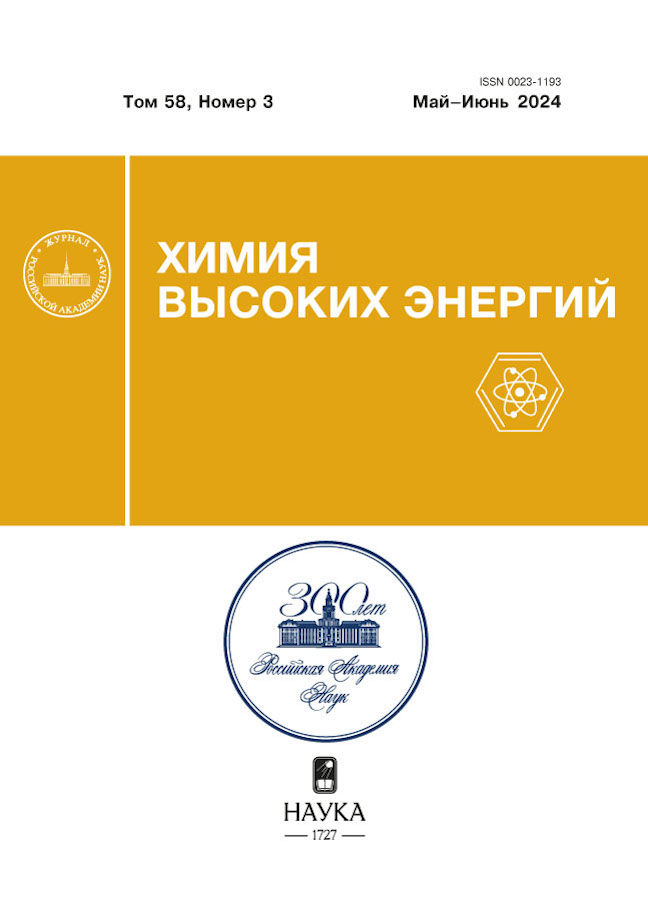Methacrylate-Containing n-Derivatives of N,N-Diethyl-4-(Phenyldiazenyl)Aniline as Initiators in Two-Photon Polymerization
- Authors: Arsenyev M.V.1, Zhiganshin E.R.1, Kolymagin D.A.2, Ilyichev V.A.1, Kovylin R.S.1, Vitukhnovsky A.G.2,3, Chesnokov S.A.1
-
Affiliations:
- G.A. Razuvaev Institute of Organometallic Chemistry of the Russian Academy of Sciences
- Moscow Institute of Physics and Technology (National Research University)
- P.N. Lebedev Physical Institute of the Russian Academy of Sciences
- Issue: Vol 58, No 3 (2024)
- Pages: 190-197
- Section: ФОТОХИМИЯ
- URL: https://ter-arkhiv.ru/0023-1193/article/view/661342
- DOI: https://doi.org/10.31857/S0023119324030022
- EDN: https://elibrary.ru/UUYGVO
- ID: 661342
Cite item
Abstract
The possibility of using a number of methacrylate-containing N,N-diethyl-4-(phenyldiazenyl)anilines with various para-substituents with respect to the azo group (-H, -Br, -NO2) as photoinitiators of radical polymerization is considered. The electrochemical and photoluminescent properties of these compounds have been studied. In the presence of azo dyes, two-photon photopolymerization of pentaerythritol triacrylate was carried out by focused radiation from a femtosecond laser with a wavelength of 780 nm. Structures with minimum linear element sizes of 94 ± 5 nm were obtained by DLW nanolithography, as well as 3D microstructures of complex architecture.
Full Text
About the authors
M. V. Arsenyev
G.A. Razuvaev Institute of Organometallic Chemistry of the Russian Academy of Sciences
Email: zhiganshinae@mail.ru
Russian Federation, Nizhny Novgorod
E. R. Zhiganshin
G.A. Razuvaev Institute of Organometallic Chemistry of the Russian Academy of Sciences
Author for correspondence.
Email: zhiganshinae@mail.ru
Russian Federation, Nizhny Novgorod
D. A. Kolymagin
Moscow Institute of Physics and Technology (National Research University)
Email: zhiganshinae@mail.ru
Russian Federation, Dolgoprudny
V. A. Ilyichev
G.A. Razuvaev Institute of Organometallic Chemistry of the Russian Academy of Sciences
Email: zhiganshinae@mail.ru
Russian Federation, Nizhny Novgorod
R. S. Kovylin
G.A. Razuvaev Institute of Organometallic Chemistry of the Russian Academy of Sciences
Email: zhiganshinae@mail.ru
Russian Federation, Nizhny Novgorod
A. G. Vitukhnovsky
Moscow Institute of Physics and Technology (National Research University); P.N. Lebedev Physical Institute of the Russian Academy of Sciences
Email: zhiganshinae@mail.ru
Russian Federation, Dolgoprudny; Moscow
S. A. Chesnokov
G.A. Razuvaev Institute of Organometallic Chemistry of the Russian Academy of Sciences
Email: zhiganshinae@mail.ru
Russian Federation, Nizhny Novgorod
References
- Jaiswal A., Rastogi C. K., Rani S., Singh G. P. et al. // iScience. 2023. V. 26. № 106374.
- Zhiganshina E.R., Arsenyev M.V., Chesnokov S.A. // Polym. Sci., B. 2023. V. 65. P. 247.
- Zhiganshina E.R., Arsenyev M.V., Chubich D.A. et al. // Eur. Polym. J. 2021. V. 162. P. 110917.
- Liu Y.J., Yang J.Y., Nie Y.M. et al. // Microfluid Nanofluidics. 2015. V. 18. P. 427.
- Sakellari I., Yin X., Nesterov M.L., Terzaki K. et al. // Adv. Opt. Mater. 2017. V. 5. № 1700200.
- Rakhymzhanov A., Gueddida A., Alonso-Redondo E., et al. // Appl. Phys. Lett. 2016. V.108. № 201901.
- Zheng C., Jin F., Zhao Yu. et al. // Sens. Actuators B Chem. 2020. V. 304. № 127345.
- Otuka A.J.G., Torres B.B.M., Dipold J. et al. // Opt. Mater. Express. 2020. V. 10. № 8. P. 1792.
- Fominykh O.D., Sharipova A.V., Balakina M.Yu. // Comput. Mater. Sci. 2019. V. 168. P. 32.
- Lu Y., Hasegawa F., Goto T. et al. // J. Mater. Chem. 2003. V. 14. P. 75.
- Beharry A.A., Sadovski O., Woolley G.A. // J. Am. Chem. Soc. 2011. V. 133. P. 19684.
- Vivas M.G., Silva D.L., De Boni L. et al. // J. Phys. Chem. B. 2012. V. 116. P. 14677.
- Zhou L., Mao J., Ren Y. et al. // Small. 2018. V. 14. № 1703126.
- Ghanavatkar C.W., Mishra V.R., Nagaiyan S. // Dyes Pigm. 2021. V. 191. № 109367.
- Xu L., Zhang J., Yin L. et al. // J. Mater. Chem. C. 2020. V. 8. P. 6342.
- McKenzie L.K., Bryant H.E., Weinstein J.A. // Coord. Chem. Rev. 2019. V. 379. P. 2.
- Balakina M.Yu., Shalin N.I., Sharipova A.V., Fominykh O.D. // Mol. Phys. 2020. V. 118. № 21–22. P. 1.
- Mendonca C.R., Baldacchini T., Tayalia P., Mazur E. // J. Appl. Phys. 2007. V. 102. № 1. P. 013109.
- Tribuzi V., Fonseca R.D., Correa D.S., Mendonca C.R. // Opt. Mater. Express. 2013. V. 3. № 1. P. 21.
- Turro N.J. Modern Molecular Photochemistry. University Science Books, 1991. P. 628.
- Vijayakumar C., Balan B., Kim M.-J., Takeuchi M. // J. Phys. Chem. C. 2011. V. 115. P. 4533.
- Lim S.L., Li N.-J., Lu J.-M. et al. // ACS Appl. Mater. Interfaces. 2009. V. 1. № 1. P. 60.
- Qiu F.X., Zhang Q., Yang D.Y. // Mater. Sci. Forum. 2010. V. 663–665. P. 645.
- Armarego W.L.F., Chai C.L.L. Purification of laboratory chemicals. Amsterdam: Elsevier Inc. Butterworth-Heinemann, 2003.
- Eltaboni F., Bader N., El-Kailany R. et al. // J. Chem. Rev. 2022. V. 4. № 4. Р. 313.
Supplementary files















